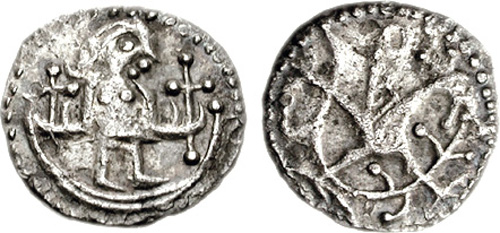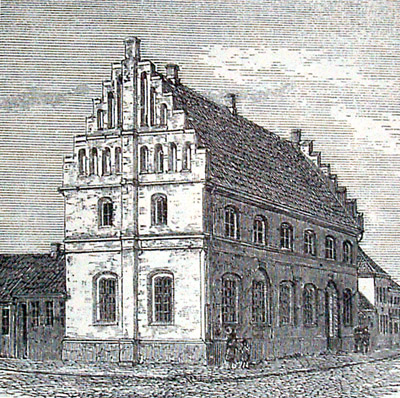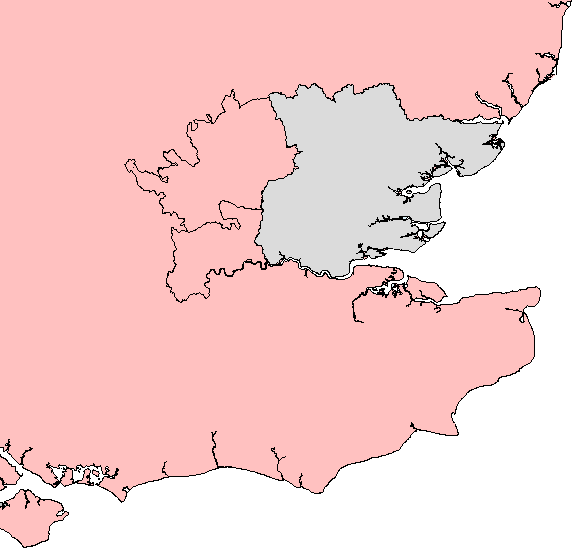|
Sceat
A sceat or sceatta ( ; , ) was a small, thick silver coin minted in England, Frisia, and Jutland during the Anglo-Saxon period that normally weighed 0.8–1.3 grams (about troy ounce). It is now (as of 2024) more commonly known in England as an 'early penny'. History Its name derives from Old English ', meaning "wealth", "money", and "coin", which has been applied to these coins since the 17th century based on interpretations of the legal codes of Mercia and of Kent under its king Æthelberht. It is likely, however, that the coins were more often known to contemporaries as " pennies" (), much like their successor silver coins. They are very diverse, organised into over a hundred numbered types derived from the British Museum Catalogue of the 1890s and by broader alphabetical classifications laid out by British numismatist Stuart Rigold in the 1970s. The huge volume of finds made in the last thirty years using metal detectors has radically altered understanding of this ... [...More Info...] [...Related Items...] OR: [Wikipedia] [Google] [Baidu] |
Aldfrith Of Northumbria
Aldfrith (Early Modern Irish: ''Flann Fína mac Ossu''; Latin: ''Aldfrid'', ''Aldfridus''; died 14 December 704 or 705) was king of Northumbria from 685 until his death. He is described by early writers such as Bede, Alcuin and Stephen of Ripon as a man of great learning. Some of his works and some letters written to him survive. His reign was relatively peaceful, marred only by disputes with Bishop Wilfrid, a major figure in the early Northumbrian church. Aldfrith was born on an uncertain date to Oswiu of Northumbria and an Irish princess named Fín. Oswiu later became King of Northumbria; he died in 670 and was succeeded by his son Ecgfrith of Northumbria, Ecgfrith. Aldfrith was educated for a career in the Roman Catholic Church, church and became a scholar. However, in 685, when Ecgfrith was killed at the Battle of Dun Nechtain, battle of Nechtansmere, Aldfrith was recalled to Northumbria, reportedly from the Inner Hebrides, Hebridean island of Iona, and became king. In his ... [...More Info...] [...Related Items...] OR: [Wikipedia] [Google] [Baidu] |
Thrymsa
The thrymsa () was a gold coin minted in seventh-century Anglo-Saxon England. It originated as a copy of Merovingian tremisses and earlier Roman coins with a high gold content. Continued debasement between the 630s and the 650s reduced the gold content in newly minted coins such that after c. 655 the percentage of gold in a new coin was less than 35%. The thrymsa ceased to be minted after about 675 and was superseded by the silver sceat. History The first thrymsas were minted in England in the 630s. These earliest coins were created at mints in Canterbury, London, and perhaps also Winchester. Charles Arnold-Baker in his '' Companion to British History'' suggests that the impetus for the creation of this coin was increased commerce following the marriage of Æthelberht of Kent and Bertha of Kent, a daughter of the Frankish king Charibert I. Thrymsas originally contained between 40% and 70% gold, but following continued debasement those coins minted after c. 655 contained less ... [...More Info...] [...Related Items...] OR: [Wikipedia] [Google] [Baidu] |
Kingdom Of Kent
The Kingdom of the Kentish (; ), today referred to as the Kingdom of Kent, was an Early Middle Ages, early medieval kingdom in what is now South East England. It existed from either the fifth or the sixth century AD until it was fully absorbed into the Kingdom of Wessex in the mid-9th century and later into the Kingdom of England in the early 10th century. Under the preceding Roman Britain, Romano-British administration the area of Kent faced repeated attacks from seafaring raiders during the fourth century AD. It is likely that Germanic-speaking ''foederati'' were invited to settle in the area as mercenaries. Following the end of Roman administration in 410, further linguistically Germanic tribal groups moved into the area, as testified by both archaeological evidence and Late Anglo-Saxon textual sources. The primary ethnic group to settle in the area appears to have been the Jutes: they established their Kingdom in East Kent and may initially have been under the dominion of the ... [...More Info...] [...Related Items...] OR: [Wikipedia] [Google] [Baidu] |
Runic Inscription
A runic inscription is an inscription made in one of the various runic alphabets. They generally contained practical information or memorials instead of magic or mythic stories. The body of runic inscriptions falls into the three categories of Elder Futhark (some 350 items, dating to between the 2nd and 8th centuries AD), Anglo-Frisian Futhorc (some 100 items, 5th to 11th centuries) and Younger Futhark (close to 6,000 items, 8th to 12th centuries). The total 350 known inscriptions in the Elder Futhark script fall into two main geographical categories, North Germanic (Scandinavian, c. 267 items) and Continental or South Germanic ( "German" and Gothic, c. 81 items). These inscriptions are on many types of loose objects, but the North Germanic tradition shows a preference for bracteates, while the South Germanic one has a preference for fibulae. The precise figures are debatable because some inscriptions are very short and/or illegible so that it is uncertain whether they quali ... [...More Info...] [...Related Items...] OR: [Wikipedia] [Google] [Baidu] |
Old English
Old English ( or , or ), or Anglo-Saxon, is the earliest recorded form of the English language, spoken in England and southern and eastern Scotland in the Early Middle Ages. It developed from the languages brought to Great Britain by Anglo-Saxon settlers in the mid-5th century, and the first Old English literature dates from the mid-7th century. After the Norman Conquest of 1066, English was replaced for several centuries by Anglo-Norman language, Anglo-Norman (a langues d'oïl, type of French) as the language of the upper classes. This is regarded as marking the end of the Old English era, since during the subsequent period the English language was heavily influenced by Anglo-Norman, developing into what is now known as Middle English in England and Early Scots in Scotland. Old English developed from a set of Anglo-Frisian or Ingvaeonic dialects originally spoken by Germanic tribes traditionally known as the Angles (tribe), Angles, Saxons and Jutes. As the Germanic settlers ... [...More Info...] [...Related Items...] OR: [Wikipedia] [Google] [Baidu] |
Penny (English Coin)
The English penny (plural "pence"), originally a coin of pure silver, was introduced by King Offa of Mercia. These coins were similar in size and weight to the continental ''denier (coin), deniers'' of the period and to the Anglo-Saxon sceats which had preceded it. Throughout the period of the Kingdom of England, from its beginnings in the 9th century, the penny was produced in silver. Pennies of the same nominal value, of a pound sterling, were in circulation continuously until the creation of the Kingdom of Great Britain in 1707. Etymology The name "penny" comes from the Old English ''pennige'' (), sharing the same root as the German language, German ''Pfennig''. Its abbreviation d. comes from the Roman ''denarius'' and was used until Decimal Day, decimalisation in 1971. Idioms Due to their ubiquity pennies have accumulated a great number of idioms to their name usually recognizing them for their commonality and minuscule value. These might include: *cut (one) off with ... [...More Info...] [...Related Items...] OR: [Wikipedia] [Google] [Baidu] |
Penny
A penny is a coin (: pennies) or a unit of currency (: pence) in various countries. Borrowed from the Carolingian denarius (hence its former abbreviation d.), it is usually the smallest denomination within a currency system. At present, it is the formal name of the British penny ( p) and the '' de facto'' name of the American one-cent coin (abbr. ¢). ''Penny'' is also the informal name of the cent unit of account in Canada, although the production of one-cent coins was ended in 2012. The name ''penny'' is also used in reference to various historical currencies, also derived from the Carolingian system, such as the French denier and the German pfennig. It may also be informally used to refer to any similar smallest-denomination coin, such as the euro cent or Chinese fen. The Carolingian penny was originally a 0.940-fine silver coin, weighing pound. It was adopted by Offa of Mercia and other English kings and remained the principal currency in Europe ... [...More Info...] [...Related Items...] OR: [Wikipedia] [Google] [Baidu] |
Ribe
Ribe () is a town in south-west Jutland, Denmark, with a population of 8,367 (2025). It is the seat of the Diocese of Ribe. Until 1 January 2007, Ribe was the seat of both a surrounding municipality and county. It is now part of the enlarged Esbjerg Municipality in the Region of Southern Denmark. It is the oldest town in Denmark. History The town was a center of commercial activity in the early 8th century, and this may have originated with royal influence. Coins may have been struck there in 720. Whichever king was involved in the digging of the Kanhave Canal may have been involved in the establishment of Ribe also. Trade contacts were mostly with Frisia and England. Of the over 300 sceatas found in Denmark, 216 come from in or around Ribe, most of them were of the Frisian Wodan type, and these were likely minted in Ribe in the early eighth century. The Ancient Diocese of Ribe was established in 948 with the consecration of Leofdag of Ribe as its first bishop. Early in t ... [...More Info...] [...Related Items...] OR: [Wikipedia] [Google] [Baidu] |
Kingdom Of Wessex
The Kingdom of the West Saxons, also known as the Kingdom of Wessex, was an Anglo-Saxon kingdom in the south of Great Britain, from around 519 until Alfred the Great declared himself as King of the Anglo-Saxons in 886. The Anglo-Saxons believed that Wessex was founded by Cerdic and Cynric of the Gewisse, though this is considered by some to be a legend. The two main sources for the history of Wessex are the West Saxon Genealogical Regnal List and the ''Anglo-Saxon Chronicle'' (the latter of which drew on and adapted an early version of the List), which sometimes conflict. Wessex became a Christian kingdom after Cenwalh () was baptised and was expanded under his rule. Cædwalla later conquered Sussex, Kent and the Isle of Wight. His successor, Ine (), issued one of the oldest surviving English law codes and established a second West Saxon bishopric. The throne subsequently passed to a series of kings with unknown genealogies. During the 8th century, as the hegemony of ... [...More Info...] [...Related Items...] OR: [Wikipedia] [Google] [Baidu] |
Anglo-Saxon England
Anglo-Saxon England or early medieval England covers the period from the end of Roman Empire, Roman imperial rule in Roman Britain, Britain in the 5th century until the Norman Conquest in 1066. Compared to modern England, the territory of the Anglo-Saxons stretched north to present day Lothian in southeastern Scotland, whereas it did not initially include western areas of England such as Cornwall, Herefordshire, Shropshire, Cheshire, Lancashire, and Cumbria. The 5th and 6th centuries involved the collapse of economic networks and political structures and also saw a radical change to a new Anglo-Saxon language and culture. This change was driven by movements of peoples as well as changes which were happening in both northern Gaul and the North Sea coast of what is now Germany and the Netherlands. The Anglo-Saxon language, also known as Old English, was a close relative of languages spoken in the latter regions, and genetic studies have confirmed that there was significant migrat ... [...More Info...] [...Related Items...] OR: [Wikipedia] [Google] [Baidu] |
Kingdom Of Essex
The Kingdom of the East Saxons (; ), referred to as the Kingdom of Essex , was one of the seven traditional kingdoms of the Anglo-Saxon Heptarchy. It was founded in the 6th century and covered the territory later occupied by the counties of Essex, Middlesex, much of Hertfordshire and (for a short while) west Kent. The last king of Essex was Sigered of Essex, who in 825 ceded the kingdom to Ecgberht, King of Wessex. Extent The Kingdom of Essex was bounded to the north by the River Stour and the Kingdom of East Anglia, to the south by the River Thames and Kent, to the east lay the North Sea and to the west Mercia. The territory included the remains of two provincial Roman capitals, Colchester and London. The kingdom included the Middle Saxon Province, which included the area of the later County of Middlesex and most, if not all, of Hertfordshire Although the province is ever recorded only as part of the East Saxon Kingdom, charter evidence shows that it was not part of its co ... [...More Info...] [...Related Items...] OR: [Wikipedia] [Google] [Baidu] |
Denmark
Denmark is a Nordic countries, Nordic country in Northern Europe. It is the metropole and most populous constituent of the Kingdom of Denmark,, . also known as the Danish Realm, a constitutionally unitary state that includes the Autonomous administrative division, autonomous territories of the Faroe Islands and Greenland in the north Atlantic Ocean.* * * Metropolitan Denmark, also called "continental Denmark" or "Denmark proper", consists of the northern Jutland peninsula and an archipelago of 406 islands. It is the southernmost of the Scandinavian countries, lying southwest of Sweden, south of Norway, and north of Germany, with which it shares a short border. Denmark proper is situated between the North Sea to the west and the Baltic Sea to the east.The island of Bornholm is offset to the east of the rest of the country, in the Baltic Sea. The Kingdom of Denmark, including the Faroe Islands and Greenland, has roughly List of islands of Denmark, 1,400 islands greater than in ... [...More Info...] [...Related Items...] OR: [Wikipedia] [Google] [Baidu] |








